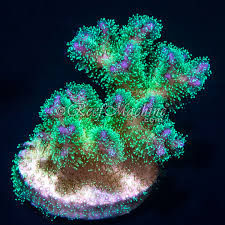Pocillopora Coral (Cauliflower Coral, Brush Coral)
• Common Name: Cauliflower Coral, Brush Coral
• Scientific Name: Pocillopora spp.
• Class: Anthozoa
• Origin: Indo-Pacific, Great Barrier Reef, Red Sea
• Category: SPS (Small Polyp Stony Coral)
• Care Level: Intermediate
• Temperament: Peaceful (but can spread via polyp bailout)
• Lighting: Medium to High (PAR 150-300)
• Flow: High (strong, random flow)
• Placement: Middle to Top (requires high water movement)
• Growth Rate: Fast
Overview:
Pocillopora, commonly known as Cauliflower Coral or Brush Coral, is one of the most adaptable SPS corals, making it a good introduction to SPS for reef keepers transitioning from LPS or soft corals. It features a bushy, compact growth structure with small polyps and comes in a variety of colors, including pink, green, brown, and purple. Pocillopora is hardy compared to Acropora and recovers well from fragging and environmental stress, making it popular in reef tanks.
Tank Requirements & Water Parameters:
Pocillopora corals require stable water parameters to thrive, similar to other SPS corals:
• Temperature: 76-80°F (24-27°C)
• pH: 8.1-8.4
• Salinity: 1.025 SG
• Alkalinity: 8-9 dKH
• Calcium: 400-450 ppm
• Magnesium: 1250-1350 ppm
• Nitrate: 2-10 ppm (requires a slight nutrient presence)
• Phosphate: 0.02-0.05 ppm
Pocillopora is less demanding than Acropora but still requires a stable environment to prevent tissue recession or bleaching.
Lighting Needs:
Pocillopora prefers medium to high lighting (PAR 150-300). It is found on upper reef slopes and shallow waters, where it receives strong sunlight.
• If placed in lower light areas, growth slows, and colors dull.
• Higher PAR levels (200-300) bring out vibrant coloration.
• Adjust placement carefully, as sudden increases in light can cause bleaching.
Flow Requirements:
Pocillopora thrives in high, turbulent flow that mimics natural reef conditions.
• Strong, random flow is ideal to prevent detritus buildup and enhance polyp extension.
• Direct, laminar flow should be avoided, as it may stress the coral and damage tissue.
• Gyre-style or pulsing wave flow setups work best.
Feeding & Nutrition:
Pocillopora relies primarily on photosynthesis through its zooxanthellae, but supplemental feeding can enhance growth and coloration.
• Ideal Foods:
• Phytoplankton
• Zooplankton
• Reef-boosting amino acids
• Feeding Frequency: 1-2 times per week via broadcast feeding.
Tip: While Pocillopora does not require heavy feeding, regular nutrient input prevents it from paling or growing too slowly.
Placement & Aggression:
• Placement: Middle to upper tank, where it can receive strong flow and lighting.
• Aggression: Peaceful, but it has an interesting feature—polyp bailout.
• When stressed, Pocillopora releases free-living polyps that can settle and form new colonies in different areas of the tank.
• This can lead to unintentional spreading if not controlled.
Growth & Propagation:
Pocillopora is one of the fastest-growing SPS corals, forming compact, tree-like structures with dense branches.
• Growth Rate: Fast
• Encrusts over rocks quickly
• Can regrow from even small fragments
Fragging Pocillopora:
• Use bone cutters or a bandsaw to cut a branch cleanly.
• Attach frags to plugs or rock with cyanoacrylate gel glue.
• Provide high flow and stable conditions for quick healing.
Popular Color Variations:
Pocillopora comes in several striking colors, depending on lighting and nutrients:
• Neon Green Pocillopora – Bright, fluorescent green with compact polyps
• Pink Pocillopora – Soft pink to deep magenta, often with darker polyps
• Purple Pocillopora – Intense purple to bluish hues
• Brown Pocillopora – Common in wild colonies, but can develop green highlights under the right conditions
Challenges & Common Issues:
• Polyp Bailout & Spreading – Pocillopora can reproduce asexually by releasing polyps, which may settle in unexpected places, leading to unwanted colonies. Regular fragging and tank monitoring help manage this.
• Bleaching – If exposed to excessive light or sudden parameter changes, Pocillopora can bleach. Acclimate it slowly to lighting changes.
• Cyanobacteria or Algae Growth – If placed in low flow areas, algae or cyanobacteria may settle on its branches, smothering the coral.
• Pale Coloration – Can occur if nutrients are too low. Ensure stable nitrate and phosphate levels to maintain vibrancy.
